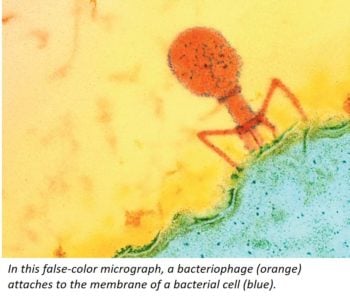NIH-funded study in mice merits further investigation as a potential treatment
A specific strain of a common bacteria found in most people with alcoholic hepatitis correlates with greater liver disease severity and mortality, according to a new study published in Nature. Alcoholic hepatitis is a serious form of alcohol-associated liver disease, and people with it have high levels of the bacterium Enterococcus faecalis (E. faecalis) in their gut. The study also found that a novel therapeutic approach that specifically targets the E. faecalis strain lessened alcohol-associated liver disease in mice. The research team was funded in part by the National Institute on Alcohol Abuse and Alcoholism (NIAAA), of the National Institutes of Health.
“This is a hopeful advance against a potentially life-threatening disease for which few effective treatments are available,” said NIAAA Director Dr. George F. Koob. “Alcoholic hepatitis has a mortality rate of more than 50% within the first 60 days of diagnosis in severe cases and is a particularly important area of focus for NIAAA. The current findings warrant further investigation as a potential novel treatment for people with alcoholic hepatitis.”
A multitude of bacteria populate the human digestive tract, and this gut microbiota plays important roles in maintaining health. With chronic alcohol misuse, the levels and types of bacteria in the gut microbiota change which contributes along with other factors to alcohol-associated liver diseases such as alcoholic hepatitis.
In analyses of gut microbes from alcohol use disorder (AUD) patients with alcoholic hepatitis, a team of scientists led by Bernd Schnabl, M.D., of the University of California, San Diego, found that fecal samples from patients with alcoholic hepatitis had about 2,700-fold more E. faecalis than samples from non-AUD controls. Further studies of E. faecalis, showed that cytolysin, a toxin secreted by specific E. faecalis strains, killed liver cells and caused liver damage in a mouse model of alcohol-associated liver disease.
“We detected cytolysin-positive E. faecalis (cytolytic E. faecalis) in fecal samples from 30% of patients with alcoholic hepatitis, and in none of the fecal samples from non-AUD controls,” said Dr. Schnabl. “Importantly, 89% of cytolysin-positive patients with alcoholic hepatitis died within 180 days after admission compared to only about 4% of cytolysin-negative patients.”
In another series of experiments, the researchers studied mice that had been transplanted with feces from the intestines of people with alcoholic hepatitis and that contained cytolytic E. faecalis. They confirmed that transplantation of the bacteria caused severe liver disease in mice. Dr. Schnabl and his colleagues then investigated the therapeutic potential of bacteria-killing viruses known as bacteriophages that specifically target cytolytic E. faecalis.
Using a mouse model of alcohol-associated liver disease, mice were transplanted with stool from cytolysin-positive alcoholic hepatitis patients and treated with a cocktail of bacteriophages targeting the cytolytic E. faecalis strains. The researchers found that mice treated with bacteriophages that target cytolytic E. faecalis had less liver injury and inflammation compared to controls. Administration of E. faecalis-targeting bacteriophage also significantly reduced levels of cytolysin in the liver.
“Taken together, our findings link cytolytic E. faecalis with worse clinical outcomes and mortality in humans with alcoholic hepatitis, and that bacteriophages can specifically target cytolytic E. faecalis in a mouse model of alcohol-induced liver disease,” said Dr. Schnabl. “A prospective clinical trial is required to validate the human relevance of our findings and to test whether this new therapeutic approach is effective for patients with alcoholic hepatitis.”
Reference: Yi Duan, C Llorente, S Lang, K Brandl, H Chu, L Jiang, RC White, TH Clarke, K Nguyen, M Torralba, Y Shao, J Liu, A Hernandez-Morales, L Lessor, IR Rahman, Y Miyamoto, M Ly, B Gao, W Sun, R Kiesel, F Hutmacher, S Lee, M Ventura-Cots, F Bosques-Padilla, EC Verna, JG Abraldes, RS Brown Jr, V Vargas, J Altamirano, J Caballería, DL Shawcross, SB Ho, A Louvet, MR Lucey, P Mathurin, G Garcia-Tsao, R Bataller, XM Tu, L Eckmann, WA van der Donk, R Young, TD Lawley, P Stärkel, D Pride, DE Fouts and B Schnabl. Bacteriophage targeting of gut bacterium attenuates alcoholic liver disease. Nature. Published online November 13, 2019.
About the National Institute on Alcohol Abuse and Alcoholism (NIAAA): The National Institute on Alcohol Abuse and Alcoholism (NIAAA), part of the National Institutes of Health, is the primary U.S. agency for conducting and supporting research on the causes, consequences, diagnosis, prevention, and treatment of alcohol use disorder. NIAAA also disseminates research findings to general, professional, and academic audiences. Additional alcohol research information and publications are available at www.niaaa.nih.gov.
About the National Institutes of Health (NIH): NIH, the nation’s medical research agency, includes 27 Institutes and Centers and is a component of the U.S. Department of Health and Human Services. NIH is the primary federal agency conducting and supporting basic, clinical, and translational medical research, and is investigating the causes, treatments, and cures for both common and rare diseases. For more information about NIH and its programs, visit www.nih.gov.
